Last Updated on December 29, 2022
Pharmacology requires you to understand both the pathomechanism of a given disease and how a drug can prevent, limit, or cure the disease. It also requires a certain amount of memorization to remember all the different classes and names of drugs.
The Handbook of Pharmaceutical Excipients (HPEC) is a quick reference to the main mechanisms of action, effects, and uses of both commonly used and more obscure drugs in a format small enough to fit in your lab coat or your backpack.
Right here on infolearners, you are privy to a litany of relevant information on best pharmacology books for pharmacy students, lippincott pharmacology, best drug reference book for pharmacists, pharmacology books for mbbs, pharmacology books for medical students, and so much more. Take out time to visit our catalog for more information on similar topics.
Pharmacology books for medical students
Lippincotts Illustrated Review: Pharmacology
Lippincott’s illustrated review is a well-known, and highly appreciated book series among medical students. known for its selection of well-organized, easily read extensive review textbooks.
Its take on pharmacology is no different. Following the same recipe, it presents the material with its student-friendly, and digestible organization, style, and diagrams.
This book has a lot going for it. Coming in at around 580 pages, it falls just short of being a full-sized textbook, but might very well fit the part.
At the same time, it’s short and concise enough to enable students to use it for basic comprehension as well as test prep review, including the USMLE.
Whether used as a stand-alone textbook or complementary review book, this book will deliver. In addition, the attractive price makes it no less desirable.
Lange: Katzung Basic & Clinical Pharmacology

Extensive, full-size textbook spanning almost 1200 pages. It contains everything you need for your course while being able to remain an easily read book that most students find to be very clear and easy to understand.
The textual information is supplemented with intuitive graphics and diagrams for better visual understanding.
The book also got you covered for the crucial for memorization of drugs that are laid out on clean and readable tables.
The book has an almost lecture-like organization that takes a systems-based approach to the subject. Under each organ system (e.g. CNS, endocrine system) all groups of drugs acting on that system are systematically presented in an orderly fashion.
This book will provide everything you need to succeed in the subject at an affordable price.
Goodman And Gilman’s Manual Of Pharmacology And Therapeutics

By many considered the ‘Bible’ of Pharmacology. This book is a heavyweight both in terms of its in-depth material, but also its actual weight.
Weighing almost 7 pounds, this book is literally about the size and weight of a brick.
While the book itself is amazing, it assumes a pretty solid understanding of a lot of concepts. It is the type of book the professor loves but the average student not so much.
Also, most students can find a better use of the money you have to fork out to get this one, which is quite a lot.
BRS Pharmacology

Similar to Lippincotts, The BRS review book series from Wolters Kluwer is a student favorite.
Following the well-known format, the BRS take on pharmacology results in a strong review book of almost 400 pages.
While the material is trimmed and compressed, it still includes lots of useful tables and diagrams to increase student comprehension.
Similar to other books in the series, this one also contains collections of USMLE-style questions at the end of each chapter.
the clean BRS layout makes it really easy to use, either as an addition to lecture material or as a test prep review book. Factors in its decent price level, this book offers a lot of value.
Best Pharmacology Books For Pharmacy Students
1. Applied Therapeutics (10th Edition)
Author: Brian K. Alldredge PharmD, Robin L. Corelli PharmD, Michael E. Ernst PharmD, B. Joseph Guglielmo Jr. PharmD, Pamela A. Jacobson PharmD, Wayne A. Kradjan PharmD, Bradley R. Williams PharmD
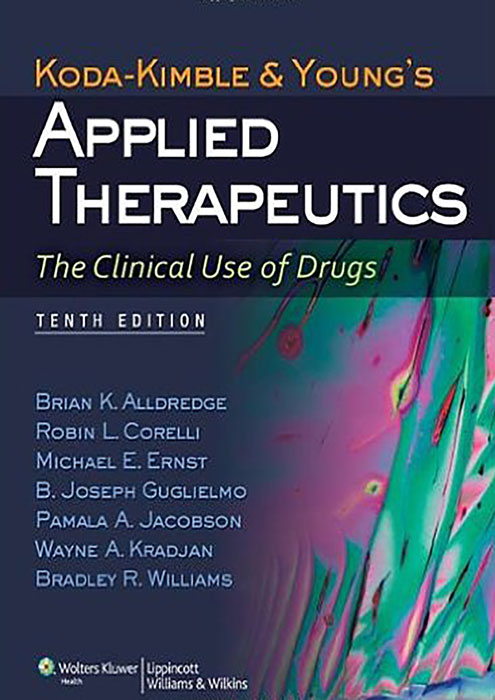
Price: $59.45
ISBN: 9781609137137
Summary of Table of Contents:
This book popularly called Koda Kimble consists of 17 sections. Section 1 is a brief explanation of medication therapy management. It also contains the assessment of therapy. Section 2 includes a detailed description of vascular and cardiac disorders. Section 3 focuses on the explanation of pulmonary disorders. Section 4 and section 5 are based on gastrointestinal disorders and renal disorders respectively. Section 6 briefly describes solid organ transplantation while section 7 deals with nutrition issues. Similarly, the rest of the sections of this book covers different disorders, diseases, and women’s health issues.
Pros:
This book is a useful one for pharmacy students. The book is quite readable and the case-based format is exceptional. It enables the student to learn all the disorders effectively. It can be considered a great resource for a therapeutics course. The book provides great algorithms and references for specific cases. It assists the students in mastering the basics of drug therapeutics. It allows the students to develop practical skills in problem-solving.
Cons:
The case-based format also makes it harder to identify the facts. The book becomes quite difficult to read for the students because of the abundance of case after case. On the Kindle version of the book, zooming is not enabled which makes it impossible to read on several occasions. The graphics and tables in the book are also unreadable at times.
Ratings: 8/10
Koda-Kimble – RxCalculations
2. Pharmacotherapy (8th Edition)
Author: Joseph DiPiro, Robert L. Talbert, Gary Yee, Gary Matzke, Barbara Wells, L. Michael Posey

Price: $35.93
ISBN: 9780071703543
Summary of Table of Contents:
This is one of the best pharmacy books written by Joseph DiPiro et al. The book consists of 16 sections. There are many disorders covered in the book. Section 1 revolves around the Bone and Joint disorders while the second section deals with cardiovascular disorders. Sections 3, 4, and 5 describe in detail the dermatologic disorders, endocrinologic disorders, and gastrointestinal disorders. Section 6 covers obstetric and gynecologic disorders. Section 8 discusses infectious diseases in detail. The next sections include the description of other disorders such as respiratory, renal, and urologic disorders.
Pros:
One of the best pharmacy books to read; this book by DiPiro is an amazing tool and guide for complex drug therapy administrations for different diseases and disorders. The author has beautifully broken down all the disease states into different components such as guidelines, symptoms, diagnosis, and other key points. It is one of the most recommended books by pharmacy school professors because it is easy to read and understand. It is a perfect resource for pharmacy students.
Cons:
The 8th edition of the book does not add much and looks almost identical to the previous edition. A few disorders are discussed in detail whereas many disease states and disorders are not discussed in enough detail which is a huge flaw in this book. The readings are condensed but with the cutting of essential contents. In different chapters, the information is cluttered.
Ratings: 9/10
Pharmacotherapy – RxCalculations
3. Applied Biopharmaceutics & Pharmacokinetics (6th edition)
Author: Leon Shargel, Andrew Yu, Susanna Wu-Pong
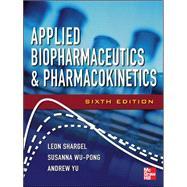
Price: $88.78
ISBN: 9780071603935
Summary of Table of Contents:
It is an incredible book written by Leon Shargel, Andrew Yu, and Susanna Wu-Pong. There are 22 chapters in the book with each chapter offering different information. Chapter 1 is the basic introduction of Biopharmaceutics and Pharmacokinetics. The second chapter discusses the mathematical fundamentals in Pharmacokinetics. The next couple of chapters are based on different models of intravenous Bolus administration. Intravenous infusion is discussed in the fifth chapter. The next few chapters focus significantly on drug clearance and elimination and dosage regimes. Another important chapter is nonlinear pharmacokinetics. The next section is completely based on the description of biopharmaceutics. The book also includes the relationship between pharmacodynamics and pharmacokinetics.
Pros:
It is a comprehensive book on practical and theoretical applications of pharmacokinetics and biopharmaceutics and assists in understanding the fundamental concepts of these two subjects. It derives the pharmacokinetic models that describe the processes of drug absorption, metabolism, and elimination. It also critically assesses the biopharmaceutic studies that involve the drug product unequivalency and equivalency. The best thing about this book is that it can help you evaluate and design dosage regimes of drugs.
Cons:
The book lacks sufficient clinical and practical examples, and this sometimes makes concepts tougher for pharmacy students to understand. Because of this complexity, this book shouldn’t be the only pharmacokinetics book students use. The part on biopharmaceutics is also less covered in the book.
Ratings: 8/10
Applied Biopharmaceutics & Pharmacokinetics
Ansel’s Pharmaceutical Dosage Forms & Drug Delivery System (11th edition)
Author: Loyd Allen

Price: $70.21
ISBN: 978081779340
Summary of Table of Contents:
The book contains 8 sections and 21 chapters. Section 1 consists of three chapters. It introduces the readers to the drug delivery system and drug dosage forms. It also discusses the drug manufacturing practices. The second section focuses on drug delivery system design and drug dosage form designs. Section 3 completely discusses the solid dosage forms and solid modified drug delivery framework. Sections 5 and 6 of the book contain the description of suppositories, sticks, inserts, and liquid dosage forms respectively. In section 7, the author gives an overview of sterile dosage forms and gives an insight on advanced delivery systems and dosage forms in section 8.
Pros:
This book allows pharmacy students to master the intricacies of pharmaceutical dosage forms and design. It takes into account CAPE, APhA, and NAPLEX competencies. It does an excellent job showing the interrelationships between pharmaceutical and biopharmaceutical principles, product design, formulation, manufacture, compounding, and the clinical application of the various dosage forms inpatient care, as well as regulations and standards governing the manufacturing and compounding of pharmaceuticals. This new edition also includes a new chapter devoted to clinical pharmaceutics. Each chapter on dosing forms also has two case studies: one clinical and one pharmaceutical to demonstrate pharmaceutical concepts in action. Grouped and individual activities in each chapter allow the pharmacy student to practice what they have studied. The inclusion of the Physical Pharmacy Capsules is an excellent tool to master important underlying pharmaceutical principles. The appendix has also been expanded to include a review of active ingredient considerations in dosing.
Cons:
Does not go straight to the point most of the time which could make it difficult for some students to read.
Ratings: 8/10
Ansel’s Pharmaceutical Dosage Forms & Drug Delivery System – RxCalculations
6. Concepts in Sterile Preparations and Aspetic Technique
Author: Pamella S. Ochoa, Jose A. Vega
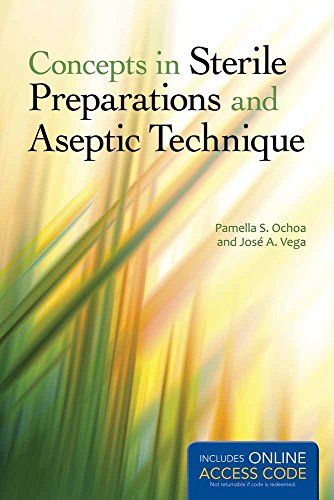
Price: $89.95
ISBN: 9781284035728
Summary of Table of Contents:
The book has a total of 11 brief chapters. The first chapter is the introduction of parenteral preparations. Chapter 2 deals with the equipment and supplies for administering and compounding sterile preparations. There is brief information provided in the 3rd chapter regarding calculations for parental compounding. Chapter 4 includes the description of microbiological considerations in parental compounding. There is an explanation of secondary and primary engineering controls in the fifth chapter. The next two chapters explain the principles of stability and compatibility and compounding manipulations and aseptic techniques. Chapter 8 prepares the pharmacy students for hazardous drugs specifically for parental use. Chapter 10 determines the considerations for intravenous drug therapy in infants and children.
Pros:
This is a perfect book that examines the best practices and standards for sterile compounding. It also provides fundamentals of the aseptic technique in an accessible manner to the pharmacy students. This is a great resource that enables the students to review the microbiological considerations and foundational parenteral calculations. It also allows the students to review all the concepts with the assistance of case studies, alerts, and tips, etc. This is an easy resource to help students master sterile preparations.
Cons:
The book is detailed but lacks brief information in some chapters. In a few parts of the book, the author leaves students confused about the concepts because of the lack of detail provided.
Ratings: 8/10
Concepts in Sterile Preparations and Aseptic Technique – RxCalculations
Drug Information: A guide for pharmacists (5th edition)
Author: Patrick M. Malone, Karen L. Kier, John Stanovich Jr. Meghan J. Malone
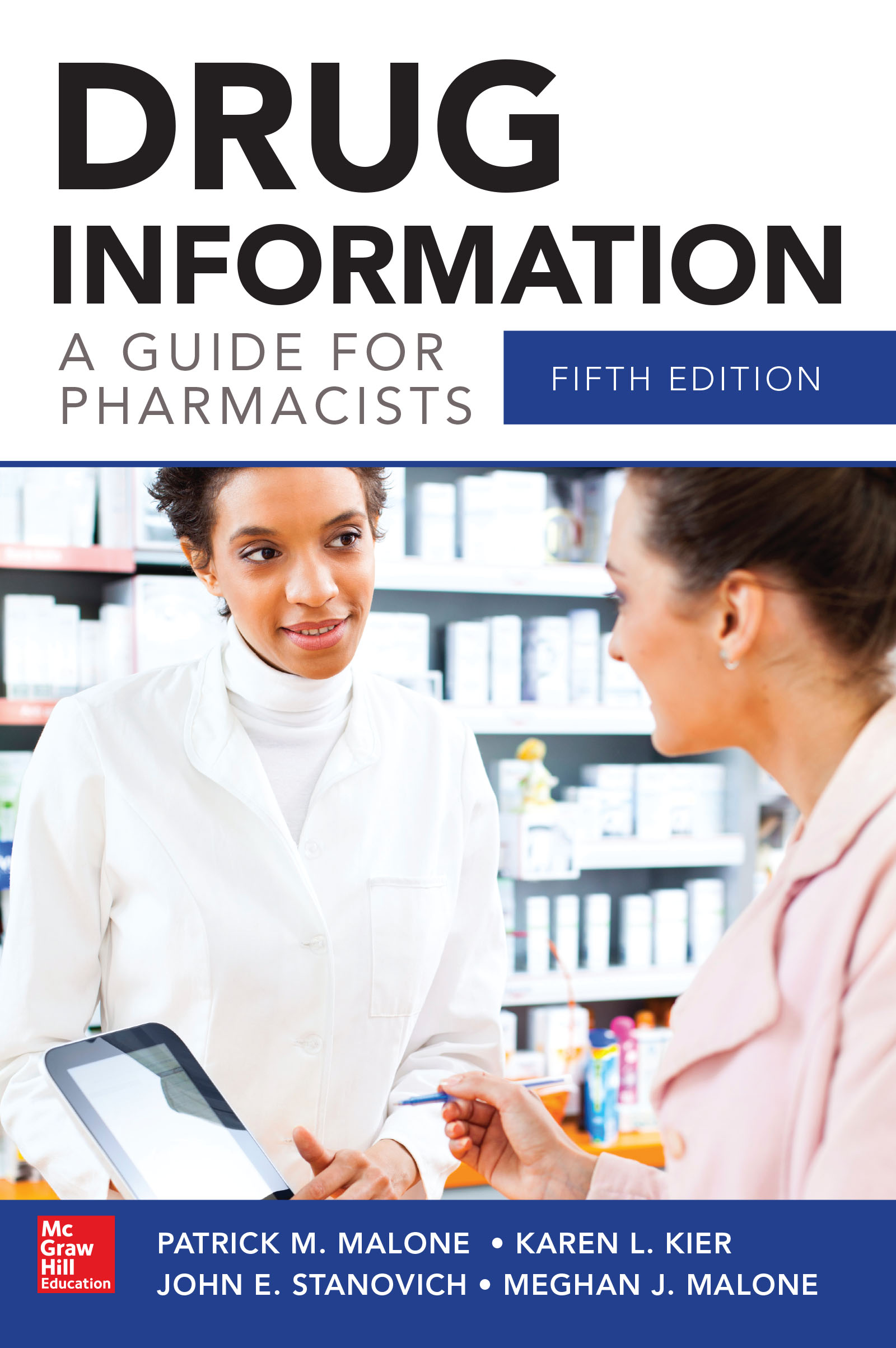
Price: $65.66
ISBN: 9780071437912
Summary of Table of Contents:
There are 24 chapters in this book. The book gives a basic introduction of the drug information in the first chapter. The initial chapters of this book offer detailed information about the drug information resources and drug recommendations. Chapter 4 is the literature evaluation on the drug. Chapter 6 is completely based on the description of the concept of pharmacoeconomics. Chapter 7 provides guidelines on evidence-based clinical practice. There are legal and ethical aspects of drug information practice discussed in chapters 10 and 11. A few chapters provide fundamental information on medication disadvantages and investigational drugs. Three chapters determine the application of drug information in the fields like ambulatory care, educational and training, and community pharmacy practice. The book concludes with instructions on enabling safe medication.
Pros:
This book is highly recommended and useful for pharmacy students. The book teaches how to effectively interpret, research, collate, and evaluate drug information. The book addresses several significant issues like ethical and legal considerations of offering drug information.
Cons:
The book does not include case studies, tables, and tips, etc. which is typical for most books. These assist students in understanding important concepts. However, they are not provided to a great extent. This raises a few concerns about this book.
Ratings: 8/10
Drug Information_ A guide for pharmacists – RxCalculations
Foye’s principles of medicinal chemistry (7th edition)
Author: Thomas L Lemke, David A. Williams, Victoria F. Roche, S. William Zito
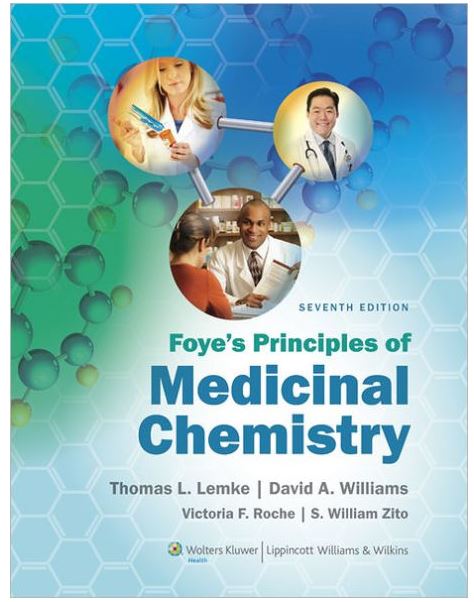
Price: $43.45
ISBN: 9781609133450
Summary of Table of Contents:
There are four parts of this book with 35 complete chapters. Part 1 of the book is the description of the principles of drug discovery. This part has many chapters focusing on drug discovery and drug design. The most significant chapter is believed to be the drug discovery through the inhibition of the enzyme. Part 2 of the book is entitled “Pharmacodynamic agents.” This part includes the description of drugs that impact the central nervous system. It also explains how the drugs impact the cardiovascular system and hormonal systems. The book also explains how drugs impact the immune and inflammatory systems. The last part of the book is focused on the management of different diseases states.
Pros:
It is a concise, clear, and understandable book. The 7th edition features updated chapters and information and is well received by the instructors as well as students of pharmacy. The book provides an unparalleled presentation of pharmacodynamic agents, drug discovery, and principles of clinical pharmacy, pharmacology, and pharmacokinetics. The chapters have been contributed by some respected researchers and academicians around the world. The book fulfills all the requirements of medicinal chemistry.
Cons:
The book does not give a comprehensive view of some of the major drug groups. Every chapter does include a general introduction. However, a detailed note is not provided on the main subjects of chemical drug classification and characteristics.
Ratings: 9/10
Pharmacy Practice and the law (6th edition)
Author: Richard R. Abood
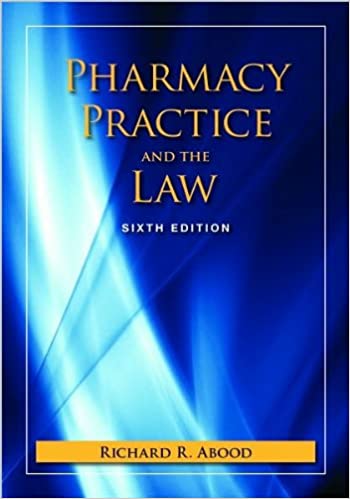
Price: $18.13
ISBN: 9781449640088
Summary of Table of Contents:
There are 8 chapters in this book. However, all chapters are brief and detailed. Chapter 1 introduces the readers to the law and legal system. The chapter describes the role of law and different sources of US law. Chapter 2 determines the legal principles and regulations of the medications. It provides information regarding different legal acts and regulatory authorities such as FDA. Chapter 3 also discusses the federal medication regulations briefly. The fourth chapter is the analysis of the closed framework of substance distribution. Similarly, the next chapter defines dispensing controlled substances. The last few chapters determine state and federal regulations of pharmacy practice. Risk management strategies are also discussed in the final chapter of the book.
Pros:
It is one of the cheapest pharmacy books available in the market. It updates the pharmacy students to account for new policies and regulatory development. It provides the background and history of the law enabling students to learn the facts. It also assists them in applying, critically evaluating, and understanding the legal aspects of pharmacy practice.
Cons:
The book’s content could be a little ambiguous. The law is often unclear specifically when it comes to pharmacy practice laws. The book has lengthy, wordy, and confusing content. The author has used difficult words that make things hard to understand. For students, clear content must be provided in the books.
Rating: 8.5/10
Pharmacy Practice and the law – RxCalculations
Medical Terminology: A programmed learning approach to the language of health care (2nd edition)
Author: Marjorie Canfield Willis
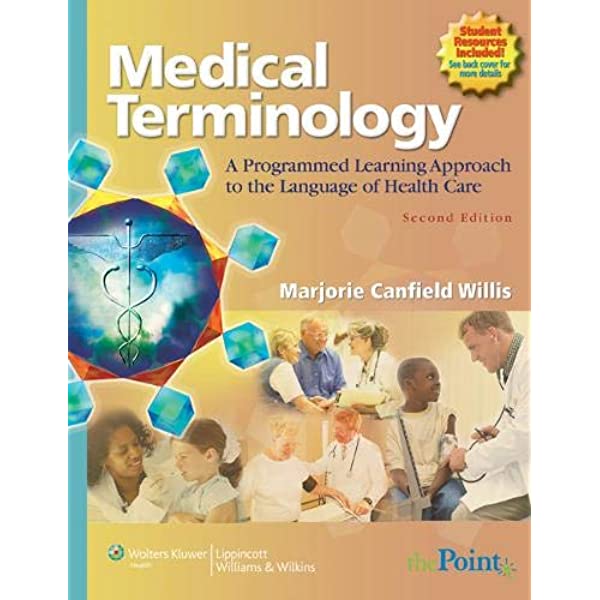
Price: $50.00
ISBN: 9780781792837
Summary of Table of Contents:
The second edition of the book contains 15 chapters. The first chapter is the general introduction. Chapter 2 contains a brief description of healthcare records. The next few chapters focus on learning healthcare approaches to different systems including Integumentary System, Musculoskeletal System, Blood, and Lymphatic Systems, Cardiovascular System, Respiratory System, Endocrine System, and Nervous System and Psychiatry. The next part of the book determines the healthcare approach to different human body parts. Chapter 10 deals with the ear and 11 deals with the eye. Chapter 12, 13, 14, and 15 includes a brief description of the Gastrointestinal System, Male Reproductive System, Urinary System, and Female Reproductive System respectively.
Pros:
The book is a must for pharmacy students. It is well written, easy to understand, and uses a self-paced study approach to make learning easier. The book is broken down into self-instruction frames and review frames for significant reinforcement and feedback. Actual medical records and medical record analysis activities are used extensively throughout the book which enriches the learning experience. It also has a variety of learning tools to accommodate a variety of learning styles. Online student tutoring and faculty support service are also available for free with the book.
Cons:
Information can sometimes be overwhelming for some pharmacy students.
Ratings: 8/10
Medical Terminology_ A programmed learning approach to the language of health care – RxCalculations
Medical Microbiology (7th edition)
Author: Patrick R. Murray Ph.D., Ken S. Rosenthal Ph.D., Michael A. Pfaller MD

Price: $61.83
ISBN: 9780323086929
Summary of Table of Contents:
The book has 7 sections and around 86 chapters. This is a lengthy book by Murray. The first section is the introduction which gives an overview of medical microbiology. Section II of the book deals with the fundamental principles of laboratory diagnosis. This includes both serologic and molecular diagnoses. The third section determines some basic concepts related to immune response. Section 4 is a detailed note on bacteriology describing the role of bacteria in diseases. Section 5 is another great note on virology. This section describes the role of viruses in diseases. Similarly, section 6 describes the role of fungi in different diseases. Section 7 determines the role of parasites in the diseases.
Pros:

It is a pretty organized book. It is a clearly written and finely broken down book into different sections. The book guides the students with the help of graphs and diagrams. Such a book is always useful for the students. It makes the content easy for the students to understand. The concepts discussed in the book are quite clear and concise. The students may never find it tough to clear their concepts. This is the best edition of the book because of the sufficient details provided in each section.
Cons:
There is coverage of basic principles. However, in several sections laboratory diagnoses are not described in detail. It is necessary to describe each aspect in detail. A few chapters of the book are quite brief and detailed while a few miss necessary information.
Ratings: 8/10
Best drug reference book for pharmacists
British National Formulary (BNF 77) March 2019
Save 50%£59.95SAVE
50%£29.98
(No VAT Payable)
Clarke’s Analysis of Drugs and Poisons (Book Only)
£535.00SAVE
5%£508.25
(No VAT Payable)
Handbook of Drug Administration via Enteral Feeding Tubes
New 3rd Edition£54.00SAVE
8%£49.68
(No VAT Payable)
Injectable Drugs Guide
£54.00SAVE
5%£51.30
(No VAT Payable)
Palliative Care Formulary (PCF7)
£59.95SAVE
5%£56.95
(No VAT Payable)
Stockley’s Herbal Medicines Interactions
£82.50SAVE
30%£57.75
(No VAT Payable)
Stockley’s Drug Interactions (12th Edition)
£240.00SAVE
12%£211.20
(No VAT Payable)
The Handbook of Pharmaceutical Excipients (7th Edition)
£355.00SAVE
5%£337.25
(No VAT Payable)

